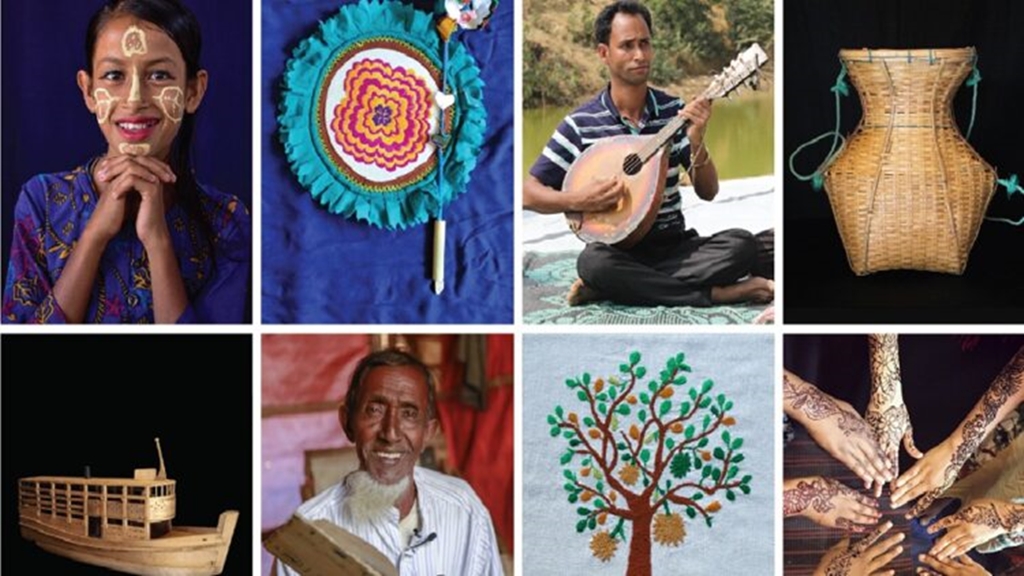
Rohingya Cultural Memory Centre launched
- 25/05/2021
- 0
By Dhaka Tribune
The centre tells the story of the Rohingyas through a comprehensive collection of cultural artefacts and artworks researched and produced by refugee artists living in the camps
The International Organization for Migration (IOM) and the Rohingya community have jointly launched the Rohingya Cultural Memory Centre (RCMC).
The multidisciplinary initiative will provide an online community space, interactive gallery, digital archive, and web-based exhibition and one of the first significant attempts to comprehensively document and preserve the heritage of the Rohingyas.
There are currently nearly one million Rohingyas living in Cox’s Bazar camps, inhabiting challenging settlements with limited avenues for expression.
The RCMC offers psychosocial support through art therapy, protection and skills development activities, led by IOM practitioners and mental health officers, said an IOM press release.
In 2019, IOM researchers in Cox’s Bazar started collecting and documenting cultural practices and artefacts shared among the Rohingya community from the Rakhine State in Myanmar.
The centre tells the story of the Rohingya people through a comprehensive collection of cultural artefacts and artworks researched and produced by Rohingya refugee artists living in the camps. These efforts produced a thorough ethnographic map, detailing activities central to the Rohingya identity.
By providing the Rohingya community with the tools and platform to tell their story, the RCMC addresses the “identity crisis” named by three-quarters of the refugees as a key factor in their loss of well-being.
The RCMC strives to function as a vehicle that preserves and enhances their rich culture, contributing towards strengthening the collective identity of the Rohingya population.
“The centre provides us with a platform to maintain our Rohingya culture and traditions,” said Shahida Win, a Rohingya poet and researcher with RCMC, adding: “It gives us an opportunity to express our creativity, aspirations, memories and feelings through our arts.”
The collection is a portrait of a culture reflecting on its past, present and future, exploring the tensions between tradition and innovation, imagination and memory, displacement and belonging. It combines objects of tangible and intangible heritage, ranging from traditional architectural models to embroidery, pottery, basketry, woodwork, visual arts, music, storytelling, poetry, and more.
“The RCMC website offers a platform for the Rohingya people to share and build their stories with a global audience and to connect with the diaspora,” said Manuel Marques Pereira, IOM’s deputy chief of mission in Bangladesh.
“By showcasing the beauty and complexity of the Rohingya heritage and people, the centre aims to empower the community and ensure the continuity of its cultural heritage for future generations,” he added.
The RCMC collection is only accessible online for the time being, but IOM is looking into finalising the construction of an integrated multi-service hall. The structure will include the exhibition and workshop spaces and will be fully managed by the Rohingya community.
The Rohingya “walk-through” experience, an interactive exhibit spanning different areas of the Rohingya life, will be accessible once the culture hall is built in the camps. A key component of the project, the cultural hall will act as a learning centre on culture and tradition for the new and old generations of Rohingya.
All the artisans and researchers involved in RCMC activities receive proper acknowledgment and authorship for their work. Additionally, the centre’s artists-in-residence programme allows them to explore new processes and materials, innovating their crafts and creating new skills development opportunities.
A dedicated Rohingya team is being trained to operate and manage the RCMC and its educational programs.
The RCMC project was developed, thanks to IOM’s ongoing collaboration with the government of Bangladesh, and the support of the Swedish International Cooperation Agency (SIDA), Canada’s Department of Foreign Affairs, Trade and Development (DFATD), the Foreign, Commonwealth and Development Office (FCDO), the Swiss Agency for Development and Cooperation (SDC), and the Ministry of Foreign Affairs of the Netherlands.






